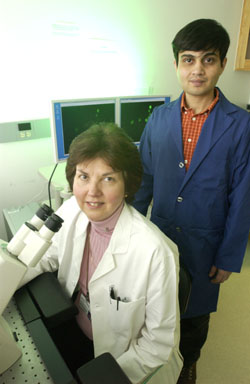
Brenda Crews, left, senior research assistant in Biochemistry and a member of the VICB and Chaitanya S. Nirodi, former instructor in Biochemistry, are two co-authors of the PNAS paper.
Differences in COX-1 and COX-2 further described
Scientists have long realized that the cousin enzymes known as cyclooxygenase 1 and 2 (COX-1 and COX-2) are important in the function of the human body. They both convert arachidonic acid to prostaglandins, which then are implicated in pain, inflammation, cell proliferation and other key biologic responses.
What hasn’t been clear is why there are two different enzymes with such similar functions. A research team from the Vanderbilt Institute of Chemical Biology has moved a step closer to answering that question with a series of findings that suggests the existence of a cell signaling pathway that involves COX-2 but not its cousin, COX-1.
“We have long thought that COX-1 and COX-2 carry out the same biochemical reactions but that they are regulated differently — that is, the switches for activating them are different,” explained Lawrence J. Marnett, Ph.D., Mary Geddes Stahlman Professor of Cancer Research and director of the VICB.
“However, COX-2 is elevated in cells that already have COX-1, so the question becomes, ‘why did nature go to the trouble of making another enzyme that does the very same thing?’ One possibility is that COX-2 may have another function that’s separate from COX-1.”
The research continues along history of COX-2 research in the Vanderbilt-Ingram Cancer Center and its A.B. Hancock Jr. Memorial Research Center, which Marnett also directs. The Proceedings of the National Academy of Science published the team’s latest findings in its early online edition last week. The paper will be published later in the print version of the journal.
Marnett’s team has found two derivatives of arachidonic acid that COX-2 can use as its substrates — “raw material” — for making prostaglandins that cannot be used as well by COX-1. These are known as 2-arachidonyl glycerol (2-AG) and anandamide.
The researchers demonstrated that of the two substrates, 2-AG is the best one for COX-2, and they have identified four final products of this selective COX-2 pathway, known as glyceryl prostaglandins.
“So now that we know they exist, the next question is whether these glyceryl prostaglandins have any biologic function,” Marnett said.
In this paper, the team further examines in cell culture one of these four glycerol prostaglandins that they have characterized, the one that seems the most abundant, known as PGE2-G. They demonstrate the ability of PGE2-G to move calcium in cells and that this mobilization of calcium in turn activates genes.
The findings suggest the possibility that PGE2-G acts through a novel receptor that can distinguish between it and a similar prostaglandin, PGE2, that is made by both COX-1 and COX-2. And, because the substrate 2-AG is oxygenated by COX-2 but not COX-1, the observations suggest the existence of a COX-2-selective cell signaling pathway controlled by glyceryl prostaglandins, the researchers write.
The next step will be to test whether the observations hold true in animal models and to link the activity to a specific biologic effect (or effects.) The researchers are focusing their research on inflammatory cells, where the two COX-2-specific arachidonic acid derivatives are most abundant, Marnett said.
“I guess you could describe these findings as interesting smoke, but we are still looking for fire,” he said. “It fills in an important blank in that it demonstrates that, yes, these molecules do have a biologic function.”
Co-authors on the PNAS paper were Dr. Jason Morrow, F. Tremaine Billings Professor of Medicine and professor of Pharmacology; Brenda Crews, senior research assistant in Biochemistry and a member of the VICB; Kevin R. Kozak, also a member of Biochemistry and the VICB; and Chaitanya S. Nirodi, former instructor in Biochemistry who recently joined the faculty in Radiation Oncology at the University of Texas Southwestern Medical School.
The work was funded by the National Institutes of Health and the Hancock Laboratory.













